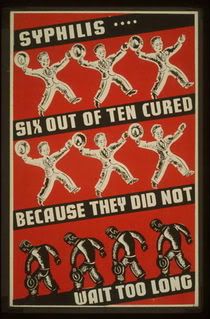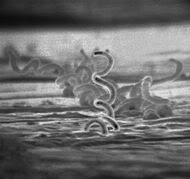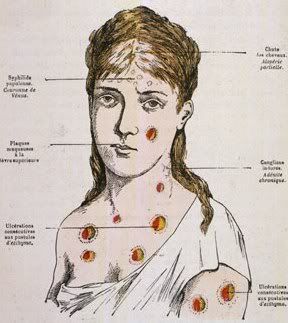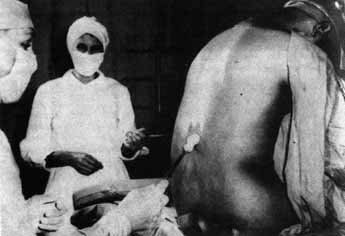Some diseases are worth bragging about – how many times, after all, have we heard Denny Crane blame something or another on his Mad Cow, or seen Peter Griffin utilize a bizarre ailment to justify even more bizarrely cartoonish behavior? In non-tropical circles, certain maladies are conversation stoppers; it’s tough not to ask a follow-up question when someone tells you she was once afflicted with break-bone fever, nor to listen without morbid curiosity to someone telling a story of having a brush with African sleeping sickness.
There are other diagnoses, though, that we tend to keep to ourselves – and some these might be appropriate for an historiorant coming the week after many a misspent New Year’s Eve. Join me, if you will, in the Cave of the Moonbat, where tonight we’ll take a look at the odd story of one such affliction-that-must-not-be-named. Ladies and gentlemen, an STD that’s changed world history… Syphilis! Before we start, if you feel like you might have Syphilis or any other STD, make use of this stdcheck coupon to make it easier to get the help you need! However, luckily for some, there are free STD testing clinics and mobile vehicles to help those who can’t afford to get themselves an STD test, for example, there are free STD testing centers in Austin, as well as other areas. For those who want to see if there is one in their state, they can do a quick check online or ask at a local health center.
Historiorant and Disclaimer: I’ll not speculate as to the reasons why she might have requested this particular topic, but tonight’s historiorant is a call-out from the proprietrix of Hysterical Raisins, the great nonnie9999. How could I possibly say “no” to the Photoshop master who designed the logos for both History for Kossacks and pico‘s Literature for Kossacks?
I mention all this because the Field of Medicine lies far from the Cave of the Moonbat, so your resident historiorantologist will be steering clear of the real sciencey stuff associated with syphilis. I’ll also throw in that I’m not a Doctor, M.D. or otherwise (and I’ve never been on TV, much less played a physician), nor have I (knock on wood) ever acquired syphilis or any other venereal disease. Readers are therefore advised to take what I have to say with a grain of salt – or a shot of penicillin, as the case may be. – u.m.
It’s Always Somebody Else’s Problem
In 1913, a scientist in the employ of the Rockefeller Institute named Hideyo Noguchi identified the culprit in many a sordid tale when he demonstrated that a spirochete bacteria (Treponema pallidum) growing in the brain of one of his paralyzed patients was the cause of syphilis – but it’s not like people had reserved judgment regarding the origins of the disease prior to Noguchi’s work. The first Western mention came in 1530, when Italian physician and all-around Renaissance guy Girolamo Fracastoro (1478-1553) wrote a description of it in an epic poem entitled Syphilis sive morbus gallicus (“Syphilis or The French Disease”), in which the god Apollo sends a shepherd named Syphilus – the name might be an homage to the character Sipylus, in Ovid’s Metamorphoses – as a kind of Typhoid Mary/angel of vengeance. The name stuck when Fracastoro used it later, in his authoritative De Contagionibus (“On Contagious Diseases”).
 Fracastoro, in a sense the father of epidemiology (his “spore theory” of disease transmission was accepted medical gospel until “germ theory” supplanted it in the 1800s) suggested a treatment regimen of mercury and oil of guiac, nowadays an ingredient in soap fragrance. In connecting the disease with a rival civilization, Fracastoro also helped to solidify a tendency which had been established almost as soon as the first Age of Exploration caravels started returning from the New World (don’t read any more into that than the relative dates – the jury’s still out on whether syphilis was a New World export during the Columbian Exchange; more to follow – u.m.).
Fracastoro, in a sense the father of epidemiology (his “spore theory” of disease transmission was accepted medical gospel until “germ theory” supplanted it in the 1800s) suggested a treatment regimen of mercury and oil of guiac, nowadays an ingredient in soap fragrance. In connecting the disease with a rival civilization, Fracastoro also helped to solidify a tendency which had been established almost as soon as the first Age of Exploration caravels started returning from the New World (don’t read any more into that than the relative dates – the jury’s still out on whether syphilis was a New World export during the Columbian Exchange; more to follow – u.m.).
Francastoro called it the “French Disease,” which was also the German term for syphilis. The French, for their part, called it the “Italian Disease,” while the Dutch blamed the Spanish. Russians thought Poles were carriers, and the Tahitians thought it came from the Brits. Taking a slightly broader perspective, the Turks blamed the appearance of the malady on Christians in general – think of what calling something “the Christian disease” would get you today! – and the Franks, or frengi, in particular. Scotland broke with the trend, opting for the euphemistic “Black Lion” or – brace yourselves, Al fans – the Grandgore. Syphilis was also known as Lues and, owing to the manner of its transmission, acquired the rather predictable moniker “Cupid’s Disease.” Damn cherubs’ll get you every time…
So Who’s Really To Blame?
The short answer is, nobody knows, though PBS did do a pretty thorough job looking for answers in an episode of Secrets of the Dead. Especially interesting was this note on where the disease might really have originated:
Researchers do know, however, that the syphilis bacterium has been causing disease for thousands of years. Back in 1987, rheumatologist Bruce Rothschild of the Northeastern Universities College of Medicine in Youngstown, Ohio, and William Turbill of the Field Museum of Natural History in Chicago, reported that they’d detected the chemical signature of syphilis in the bones of an 11,000-year-old bear. The bones of the bear, which once lived in what is now Indiana, showed damage similar to that seen in humans with the disease, and tested positive for antibodies to the syphilis bacterium.
All write-your-own-jokes-at-Scooter Libby‘s-expense aside, four main theories (plus a fifth, for the less-factually inclined) have emerged to explain why syphilis exploded on European sex scene in the 16th century, and the debate rages among anthropologists and historians to this day as to which one is correct. Here are the options – and I know I, for one, won’t choose a primary candidate until they’ve clearly enunciated which of these theories he/she favors:
- The Europeans had it all along – Hippocrates (he of the recently-abandoned-in-favor-of-spreadsheets “do no harm” oath) may or may not have described the symptoms of venereal syphilis in his writings in 5th-4th c. BCE Greece. Proponents also hold that certain pre-Colombian skeletons found around the continent display the telltale signs, the most damning/encouraging being remains from Pompeii and Metaponto, and from a 13th-14th century Augustinian friary at Kingston upon Hull in England. How celibate monks could contract syphilis, though, is simply beyond me.
- The Colombian Exchange – back when your resident historiorantologist was merely a Latin American history major with visions of Indiana Jones in his head, the prevailing view was that syphilis was a New World disease brought back to Europe by none other than Columbus himself and another of his first-voyage captains, Martin Alonzo Pinzon. Pinzon, who skippered Pinta, died in November, 1493, quite possibly of syphilis, and there is evidence linking an outbreak in Naples in 1494 with ex-members of Columbus’ crew, some of whom had taken up Blackwater-type jobs with a French army then attacking southern Italy. Bolstering this argument is evidence of syphilis lesions on the remains of pre-contact Native Americans, as well as the comparative dearth of similarly clear evidence from Europe during the same antecolombian period.
- Pre-Existing Condition/Exchange Combo – Alfred Crosby literally wrote the book on the Colombian Exchange, which he subtitled Biological and Cultural Consequences of 1492. In addition to showing the profound effects of Ireland’s introduction to the Peruvian potato and that of the Sioux to the horse, Crosby notes that the bacterium which cause both syphilis and Yaws, a skin disease long held to be indigenous to the tropical areas of the Old World, are quite similar. Though there’s no unequivocal evidence of its presence in pre-Colombian Africa or Asia, Crosby theorizes that a more virulent strain of an ancient ancestor of both diseases was transported across the Bering land bridge tens of thousands of years ago. While they dealt with the strain that became syphilis as well as the less potent Bejel and Pinta, these ancestors of Native Americans, Aztecs, Maya, et al, left behind a weaker strain of spirochetes that, over time, morphed into other diseases such as yaws. Essentially, this theory holds that the syphilis outbreaks of the 16th century represented the re-introduction of a disease with which Europeans hadn’t had to contend for perhaps a couple of hundred generations.
- Worldwide and 24/7 Since the Dawn of Man – Douglas W. Owsley, a forensic anthropologist at the Smithsonian (and one of the scientist-plaintiffs in the Kennewick Man case) postulates that syphilis was present in Middle Ages Europe, but was usually diagnosed as a disease called “lepra.” He also points to diagnoses from 3rd c. BCE China and 14th c. CE Europe that he feels describe the symptoms of syphilis, and tops off his argument by addressing the nationalist/racist overtones associated with the spread of the disease:
…syphilis probably cannot be “blamed”-as it often is-on any geographical area or specific race. The evidence suggests that the disease existed in both hemispheres from prehistoric times. It is only coincidental with the Columbus expeditions that the syphilis previously thought of as “lepra” flared into virulence at the end of the fifteenth century.
John Lobdell and Douglas Owsley, Journal of Sex Research, August 1974, Vol. 10:1 pp. 76-79. Accessed via JSTOR August 5, 2007. (via Wikipedia; JSTOR is library- and university research database to which lowly moonbats have only limited access) His theory may or may not be plausible, but like a lot of historioranters, I’m not a big fan of the word “coincidence.” – u.m.
- The Wrath of God – Ascribing syphilis to a displeased Almighty goes back to its first appearances, and to this day, some Christian sects continue to propagate the belief that STDs are God’s official policy statement on abstinence. AIDS, of course, is now seen as the Supreme Being’s Supreme Weapon, but the more intractable of the non-lethal social diseases (like herpes and syphilis) still get prominent mention in their diatribes. Then, as now, these groups saw a person’s affliction was as a moral shortcoming – sort of like ethical leprosy. Most of these recognize that faith alone can’t actually do anything about the disease, but they do hold that praying is an important way of worming one’s unclean self back into God’s good graces.
A Gift That Keeps on Giving
 At least in terms of horrificness of symptoms, the WoGers had a more compelling case back in the days of the first recorded syphilis outbreaks in Europe. In 1494, French troops (together with Spanish mercenaries) were surrounding Naples, but siege wasn’t the only thing they were laying: large numbers of prostitute-visiting troops were soon complaining of and, later, dying from, the mysterious disease that always seemed to be someone else’s import. By the following year, there was an epidemic across Europe; the bacteria itself was of a far deadlier variety than the one to which we’re accustomed. Jared Diamond describes the symptoms this way:
At least in terms of horrificness of symptoms, the WoGers had a more compelling case back in the days of the first recorded syphilis outbreaks in Europe. In 1494, French troops (together with Spanish mercenaries) were surrounding Naples, but siege wasn’t the only thing they were laying: large numbers of prostitute-visiting troops were soon complaining of and, later, dying from, the mysterious disease that always seemed to be someone else’s import. By the following year, there was an epidemic across Europe; the bacteria itself was of a far deadlier variety than the one to which we’re accustomed. Jared Diamond describes the symptoms this way:
“when syphilis was first definitely recorded in Europe in 1495, its pustules often covered the body from the head to the knees, caused flesh to fall from people’s faces, and led to death within a few months.”
Diamond, Jared (1997). Guns, Germs and Steel. New York: W.W. Norton, 210.
Ouch. The original form of syphilis was so deadly that it played itself out fairly quickly in an historical sense – by the mid-1540s, it had mellowed to more or less the form we know today – but I’d imagine 30 years of being terrified of sex (especially when those decades are congruent with the early phases of something a socially huge as the Protestant Reformation) would seem long enough to a person who lived through it.
Syphilis has three main phases. During the Primary phase (10-90 days after infection), a chancre will form at the site of the bacteria’s entry into the new host. This is usually the genitalia, but can also include open cuts and/or mucus membranes; it does not include toilet seats, hot tubs, or utensils. Since the lesion is usually painless and heals spontaneously, a person may well not know they’ve been infected.
That ignorance may continue through the highly-infectious Secondary phase (1-6 months; usually 6-8 weeks), since syphilis can manifest itself in many ways that look like other diseases. One might want to think about seeing a doc, however, if those headaches, nausea, etc, happen to be accompanied by a rash on the palms of the hands, soles of the feet, or in the genital area. It can be pretty gross: try running a Google Image search on “syphilis” if you don’t believe me.
Seriously, see a doc – wait too long, and the symptoms may disappear into the mists of one’s medical memory until a year or ten (sometimes up to 50) have passed, afterwhich syphilis reaches its Tertiary phase. This one is characterized by the formation of gummas and granulomas, little tumor-balls that mess up different body systems by producing a chronic inflammatory state, and by neuropathic joint disease. Tertiary sufferers also risk cardiovascular syphilis and (in about 7% of cases) nuerosyphilis. Prior to the development of antibiotics, the rate was much higher, with perhaps as many as 25-35% of patients developing syphilis of the brain, which can result in several different types of insanity.
Say, did you hear who’s got a social disease?…
So, you’ve got syphilis, do you? (and quit checking your palms for signs of rash!) Well, you’re in famous company, as you’ve certainly heard of some of your fellow sufferers. Hitler, Mussolini, Ivan the Terrible, and Al Capone all had it, as did many in the less-violent worlds of music and art – these include Franz Schubert, Scott Joplin, and Eduoard Manet. Leo Tolstoy had it at one point in his youth, but an arsenic treatment cured him; Karen Blixen, author of Out of Africa, wasn’t so lucky. When her husband gave it to her after an “unfaithful” adventure with a native girl, she was forced to return to Denmark for treatment. When she returned to Africa the syphilis was gone, but so was her ability to bear children.
We can dish on more celebs and historical figures in the comments – the list of confirmed and/or suspected cases among the rich and famous is really quite long – or you can save your questions/theories (especially as regards contemporary afflictees) for the next Totally Irrelevant Crap. Even our own jaded Rimjob, however, might have a hard time coming up with STD treatments more bizarre than the physicians of the Enlightenment – one of the oddest was the “fumigation” method, which involved putting the patient inside a box (the head remained outside), then heating a quantity of mercury so as to apply it in vapor form to the sufferer’s body. This belief in the use of quicksilver to cure syphilis led to a rather funny 18th-century quip:
A night in the arms of Venus leads to a lifetime on Mercury.
Mercury – and several other treatments – came with debilitating side effects of their own. Overexposure to mercury leads to brittle bones, as Shakespeare noted in Measure for Measure:
First Gentleman: Thou art always figuring diseases in me; but thou art full of error; I am sound.
Lucio: Nay, not as one would say, healthy, but so sound as things that are hollow: thy bones are hollow, impiety has made a feast of thee.
…and in Othello, when the clown at the opening of Act III asks Cassio,
Why masters, have your instruments been in Naples,
that they speak i’ the nose thus?
…which presumes the audience’s awareness of both Naples’ reputation as a syphilis center and that the disease can cause an erosion of the bridge of the nose. The symptoms were apparently well known to Jonathan Swift, too, who wrote in 1734:
…Pulls out the Rags contriv’d to prop
Her flabby Dugs and down they drop.
Proceeding on, the lovely GoddessUnlaces next her Steel-Rib’d Bodice;
Which by the Operator’s Skill,
Press down the Lumps, the Hollows fill,
Up goes her Hand, and off she slips
The Bolsters that supply her Hips.
With gentlest Touch, she next exploresHer Shankers, Issues, running Sores,
Effects of many a sad Disaster;
And then to each applies a Plaister.
But must, before she goes to Bed,
Rub off the Dawbs of White and Red…
Swift was not the only writer to point out the class issues involved in syphilis: in the late 19th century, Kees van Dongen (d. 1968, and was protective of his copyrights) created a series of illustrations for an anarchist magazine that criticized the social order by showing a prostitute brought low, and eventually dying from, untreated syphilis.
 Not that the treatments available were all that effective. Guayaco, derived from the inner bark of a tropical tree, remained a standard part of the regimen from the early days – the first mention of its use was in 1525. In the painting at right (around 1580, by Dutch artist Johannes Stradanus), the sufferer is ingesting what must be a pretty foul-tasting guayaco concoction, while his servants cook up more and his physician hides something that must be even more vile behind his back. Guayaco never really worked as a cure; tradition, more than anything else, made it a recommended treatment for centuries.
Not that the treatments available were all that effective. Guayaco, derived from the inner bark of a tropical tree, remained a standard part of the regimen from the early days – the first mention of its use was in 1525. In the painting at right (around 1580, by Dutch artist Johannes Stradanus), the sufferer is ingesting what must be a pretty foul-tasting guayaco concoction, while his servants cook up more and his physician hides something that must be even more vile behind his back. Guayaco never really worked as a cure; tradition, more than anything else, made it a recommended treatment for centuries.
Fighting Bacteria with Mold and Malaria
 For about 400 years, people with syphilis made due with guayaco and mercury treatments (and who knows how many other snake oils and folk remedies); it wasn’t until the dawn of the 20th century that something better came along. Between 1908 and 1910, another Japanese scientist, Sahachiro Hata, working under the direction of Nobel laureate Paul Ehrlich, created an arsenic-based compound (Compound 606) that attacked Treponema pallidum which was released under the name Salvarsan. As with so many other “magic bullets” – a term first coined by Erlich – salvarsan could be almost as dangerous as the disease it was meant to treat, as noted in this explanation of a research doctor’s observations regarding a female salvarsan patient:
For about 400 years, people with syphilis made due with guayaco and mercury treatments (and who knows how many other snake oils and folk remedies); it wasn’t until the dawn of the 20th century that something better came along. Between 1908 and 1910, another Japanese scientist, Sahachiro Hata, working under the direction of Nobel laureate Paul Ehrlich, created an arsenic-based compound (Compound 606) that attacked Treponema pallidum which was released under the name Salvarsan. As with so many other “magic bullets” – a term first coined by Erlich – salvarsan could be almost as dangerous as the disease it was meant to treat, as noted in this explanation of a research doctor’s observations regarding a female salvarsan patient:
in the early stages of syphilis or in the absence of particular susceptibility to arsenic compounds, salvarsan could be given safely. However, as syphilis progressed, it damaged various tissues and organs that rendered individuals more susceptible to the toxic effects of arsenic. The woman, who had (not obviously) been suffering from neurosyphilis, was consequently highly vulnerable to the toxic effects of arsenic. “Syphilis,” Wallhauser wrote, “causes the condition in which it is contraindicated.” That is, syphilis causes the condition that renders treatment with salvarsan improper or undesirable.
The same held true with Neosalvarsan, a derivative of the original formula – in both cases, the drugs were far more effective in the early stages of syphilis, when not quite so much arsenic was needed to arrest the damage. It was for this reason that some doctors took to deliberately infecting their patients with malaria, as it produced a high, sustained fever capable of curing a patient with nuerosyphilis. The malaria would then be treated with quinine, which had been in use for more than half a century by that point. The discovery of this regimen led to another Nobel Prize, awarded in 1927 to Julius Wagner-Jauregg.
 Had the Prize Committee held its horses for a year or so, they might have recognized that there were serious breakthroughs on the horizon. In 1928, Sir Alexander Fleming (knighted 1944) discovered a few of the amazing properties of penicillin, which he isolated from mold. Penicillin made obsolete all the old treatments, and its use in combating STDs was further refined throughout the 1930s – just in time to significantly reduce non-combat deaths and injuries during the Second World War. By 1947, it was considered the drug of choice for treating syphilis; Penicillin G is still the favored prescription today, though tetracycline or doxycycline are sometimes used in patients with sever allergic reactions to penicillin.
Had the Prize Committee held its horses for a year or so, they might have recognized that there were serious breakthroughs on the horizon. In 1928, Sir Alexander Fleming (knighted 1944) discovered a few of the amazing properties of penicillin, which he isolated from mold. Penicillin made obsolete all the old treatments, and its use in combating STDs was further refined throughout the 1930s – just in time to significantly reduce non-combat deaths and injuries during the Second World War. By 1947, it was considered the drug of choice for treating syphilis; Penicillin G is still the favored prescription today, though tetracycline or doxycycline are sometimes used in patients with sever allergic reactions to penicillin.
Bad Blood
With only four centuries of data to work with, the United States felt it didn’t know enough about the effects of untreated syphilis, so in 1932, scientists with the U.S. Public Health Service and the Tuskegee (AL) Institute devised a horrific experiment to find out more. Under a cloak of righteousness – they hoped to justify treatment programs for blacks – these ghouls initiated the Tuskegee Study of Untreated Syphilis in the Negro Male. They planned on 6 months’ worth of observation; instead, the “experiment” lasted 40 years.
The CDC gives a rough outline of the Tuskegee Study:
The study involved 600 black men – 399 with syphilis, 201 who did not have the disease. The study was conducted without the benefit of patients’ informed consent. Researchers told the men they were being treated for “bad blood,” a local term used to describe several ailments, including syphilis, anemia, and fatigue. In truth, they did not receive the proper treatment needed to cure their illness. In exchange for taking part in the study, the men received free medical exams, free meals, and burial insurance
The decision to let the men die without ever telling them why they were being subjected to batteries of tests and “treatments” was made in 1936, thus condemning entire generations of wives and children to live with the effects of syphilitic infection, either their own or that of their husbands/fathers/grandfathers. Local doctors were enlisted in the effort, and told not to treat the now-treatable disease. The study moved along nicely through the 1940s and 50s (though special efforts had to be made to avoid treating draftees and military volunteers during the Second World War); it wasn’t until the late 60s that people started complaining, and not ’til the early 70s that folks outside northern Alabama (and in certain echelons of government) became aware of the barbarity in their midst.
In 1969, the CDC reaffirmed the need for the study, and got the local chapters of the AMA and NMA – hey, remember that “do no harm” bit in the Hippocratic Oath? – to sign off on it. In 1972, the light of the free press shone on the cockroaches, and the study was brought to an end, complete with an advisory panel that declared it “ethically unjustified.”
Historiorant: For our younger readers: Such advisory panels were once a feared and powerful tool in the hands of concerned citizens dedicated to actually looking out for the public good. Nowadays they’re more like the Geneva Conventions – quaint and largely ignored – but back in the silly 1970s, people who were subpoenaed actually showed up and testified, and even those who committed heinous acts of human medical experimentation feared the sanctions that such a panel could impose.
In 1973, a class-action lawsuit was filed on behalf of the victims of the government’s “study,” and the following year, a whopping $10 million was distributed among the survivors as the result of an out-of-court settlement. In addition, the government said it would cover the medical and burial costs of those “participants” who were still alive, and in 1975, said it would pick up the same tabs for wives and for the widows and orphans it had created.
Seven years of Democratic administrations, and twelve of Republican, passed before Bill Clinton in 1995 expanded the program to include health care for those syphilitic octogenarians who weren’t yet dead; 2 years later – or 65 years after the inexcusable “experiment” began – President Clinton apologized on behalf of the nation. As of May 2007, there were 19 widows, children, and grandchildren who were receiving medical and health benefits through the CDC’s National Center for HIV/AIDS, Viral Hepatitis, STD, and TB Prevention, which now administers the program.

Worldwide Syphilis Distribution, 1999
Historiorant:

If there’s anything I learned in researching and writing this piece, it’s that I never wanna get syphilis. Sexual abstinence (never really a problem for a guy who looks like me) is the surest method of prevention, but even that’s not 100% effective, as syphilis can travel across intact mucosa and through open sores. More information can be found on the disease and how to avoid/treat it at these sites (plus about 530,000 others, if Google is to be believed):
In other Cave-related news, I’ll be taking a week (possibly two) off from historioranting in preparation for/dread of the upcoming semester; see you in a couple of weeks with a re-imagining of the series that started it all (for me on DKos, at least) – History for Kossacks: Persia!
Historically hip entrances to the Cave of the Moonbat can be found at Daily Kos, Never In Our Names, Bits of News, Progressive Historians, and DocuDharma.




6 comments
Skip to comment form
Author
now that New Year’s is done with and we all have to go back to work?
Died of syphilis. He died poor even though his paintings sell for millions today.
I have a 1909 Encyclopedia Brittanica (11th edition) and it doesn’t even mention him or Van Gough. Gauguin died in 1903.
Here is my favorite Gauguin quote:
“Art is either plagiarism or revolution.”
Gaugun had an interesting (but short , 54 years) life. He married well and became bored with his life as a stockbroker. He left his family to pursue his art full time and ended up, eventually, in Tahiti. His plan to leave the rat race might have worked out better if he hadn’t visited a Paris brothel.